April 28 - May 4, 2013: Issue 108
Pittwater Fire-Boats
It may seem obvious that a nation with such a combustible landscape and an integral maritime history have a fire-boat or fire-float fleet to protect waterside facilities and the vessels on the water.
The history of fire brigades in NSW, at first following the UK system during the 1830's-40's where insurance companies provided fire fighters and people had to pay to have them attend, did not become a Government overseen and regulated practice until 1884. Although discussed in parliament as early as June 15, 1854 after the Tooth and Co brewery on Broadway burnt for five days, prior to 1884 most fires were fought by convicts and soldiers. Insurance company brigades would only attend fires with their badges affixed to the premises.
News of another fire in the Summer of 1850, which was racing towards Pittwater, tells how ill-equipped people were to defend life and property from bushfires:
CONFLAGRATION ON THE NORTH SHORE.— Since Wednesday last, raging and wide-spreading fires, caused by the prevailing hot winds, and the unusual heat and dryness of the weather, have destroyed property of considerable value on the North Shore; and it is feared that the lives of two persons (known as John the Frenchman and Joseph Curran) have also been sacrificed. At the time of our going to press, the casualties, as far as could be ascertained, were as follows:- Mr. Cook's premises, Lane Cove, have been burned, and two of his horses destroyed. Mr. Archbold's premises, furniture, ... feet of sawn timber, and twelve tons of hay, burned. Mr. Simpson's orchard and fencing: Mr. Clarke's hut and furniture: John Macmillan's orchard and fencing; Mr. Lyon's hut and furniture : Mr. Murphy's two houses and furniture ; Mr. Ross Donnelly's outhouses ; F. M'Cudden's house and furniture; all entirely destroyed. The premises of Colonel Harney, Mr. Derry, Mr. Stirling, and Mr. Bloxsome, have been partially damaged, and almost all the fencing burned. It is to be feared, that no chance of arresting the progress of the main current of the fire presents itself until it reaches the basin of Pittwater. We regret to state that among the sufferers are several who, with their families, are plunged into utter destitution by this visitation; but we sincerely hope that the sympathy of the public, if appealed to, will assist in relieving their calamities to some extent. It is perhaps useless now to express surprise at the absence of all precautions against the attack of a foe whoso progress it is so difficult to arrest when once he commences his march of devastation. Here we find valuable plantations entirely unprotected, when by a little labor and outlay in clearing the grass and brushwood, the ruinous consequences we are recording might have been considerably modified if not entirely prevented. Intelligence has also been received that the bush between Wollongong and Kiama was one entire mass of flame. Communication-between the two localities was wholly impossible. LOCAL INTELLIGENCE. (1850, January 12). Bell’s Life in Sydney and Sporting Reviewer (NSW : 1845 - 1860), , p. 2. Retrieved from http://nla.gov.au/nla.news-article59770026
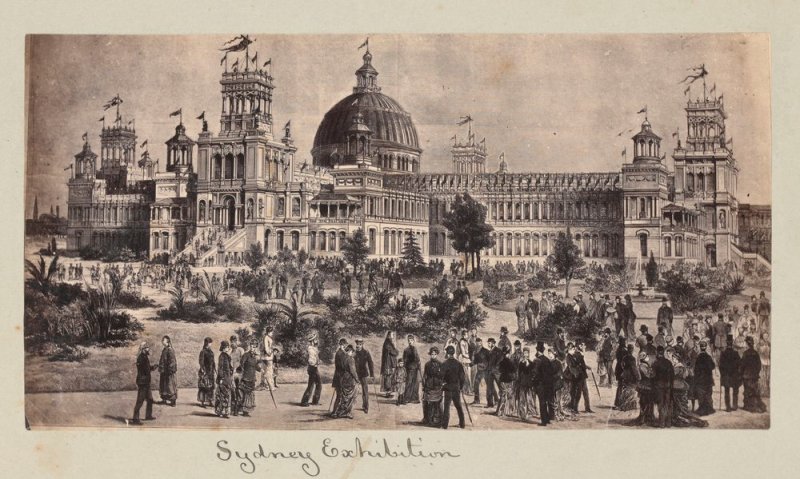
Australian International Exhibition, Sydney, 1879-1880 at the Garden Palace. Image No.: H24950, courtesy State Library of Victoria.
On September 22nd 1882 the Garden Palace, venue of the 1879 Sydney Exhibition, was destroyed by fire. This loss of a resplendent building and all the works and records it held was added impetus to change the way fires were dealt with;
Pending the passing of the Fire Brigades Bill now before Parliament, the Insurance Companies Fire Brigade is being carried on under the control of the Government. According to a resolution of the Insurance Companies, the brigade passed from their charge at the end of the year, and without some arrangement such as that which has been made by the Government the city might, from the beginning of the present year until the Fire Brigades Bill has finally passed both Houses of Parliament, be left at the mercy of any fire that breaks out. The chairman of the Fire Insurance Companies' Fire Brigade, Mr. M. W. S. Clarke, has received, for the information of the Fire Brigade Committee, a letter from the Colonial Secretary, intimating that the Government would be prepared to take over the fire brigade and its- appurtenances from –the insurance companies from the 31st December, as soon as the bill finally passed, and requesting the companies to keep the brigade in working order for another month, when the Colonial Secretary hoped to be able to act under the bill. The expenses of the brigade from the end of the year will, we believe, be borne by the Government. NEWS OF THE DAY. (1884, January 8). The Sydney Morning Herald (NSW : 1842 - 1954), p. 7. Retrieved from http://nla.gov.au/nla.news-article13550294
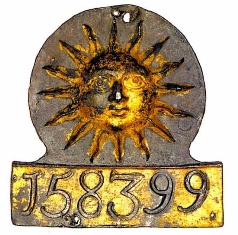 Left: Fire Mark of the Sun Fire Office - Isle of Man. Such signs were used by Georgian era insurance companies to indicate that a building was covered by its fire insurance. The first recorded fire-float was built in 1765 for the Sun Fire Insurance Company in London. This was a manual pump in a small boat, rowed by its crew to the scene of the fire. A similar craft was built in Bristol by James Hillhouse for the Imperial Fire Insurance Office in the 1780s. All fire fighting in Bristol was carried out either by private insurance companies or the Docks Company until the formation of the Bristol Fire Brigade as a branch of the police in 1876. Fireboat. (2013, April 23). In Wikipedia, The Free Encyclopedia. Retrieved from http://en.wikipedia.org/w/index.php?title=Fireboat&oldid=551822212
Left: Fire Mark of the Sun Fire Office - Isle of Man. Such signs were used by Georgian era insurance companies to indicate that a building was covered by its fire insurance. The first recorded fire-float was built in 1765 for the Sun Fire Insurance Company in London. This was a manual pump in a small boat, rowed by its crew to the scene of the fire. A similar craft was built in Bristol by James Hillhouse for the Imperial Fire Insurance Office in the 1780s. All fire fighting in Bristol was carried out either by private insurance companies or the Docks Company until the formation of the Bristol Fire Brigade as a branch of the police in 1876. Fireboat. (2013, April 23). In Wikipedia, The Free Encyclopedia. Retrieved from http://en.wikipedia.org/w/index.php?title=Fireboat&oldid=551822212
The first to follow this practice in Sydney was the Australian Insurance Company in May 1836. They too issued badges to be nailed to buildings. In 1837 the City of Sydney Building Act established a building code that included the erection of party-walls between terraces to stop fire spreading, set up firecocks’ on water mains throughout the city and added incentives to fire companies to attend; the first engine to arrive and put water onto the flames received 30 shillings, 20 for the second,and 10 for the third. As an added incentive wharfies who joined the firemen were exempt from having to serve at sea as mariners.
A TELEGRAM from London appeared in our issue of yesterday stating that the Agent-General was consulting with Captain Shaw, Superintendent of the London Fire Brigade, in reference to the appointment of a superintendent for the Sydney Fire Brigades under the Fire Brigades Bill now before Parliament. We understand that the Colonial Secretary, desires to obtain from England a thoroughly experienced and competent man, and that he directed the Agent-General to consult Captain Shaw, of the London Fire Brigades, and the heads of the principal insurance offices in London that have agencies or branches here, in order to obtain the best officer available. No information has yet been received by the Colonial Secretary from the Agent-General on the subject. According to the bill as it is now before Parliament, it rests with the Governor to appoint a superintendent of firs brigades for the metropolitan district, at such a salary as Parliament may sanction. The duties of the superintendent will be to control and direct operations at all fires, and to take and direct any measures which may appear to him to be necessary or expedient for the protection of life and property, or for the control and extinguishment of fire. He will also have certain general duties and powers with reference to the principal fire brigade over which he will be appointed superintendent, and his authority will be recognised by all officers and members of the police force, and all other persona. A deputy superintendent will be appointed under the bill, but this officer will be obtained in Sydney, as it is considered unnecessary to send for an officer of this grade from England. NEWS OF THE DAY. (1884, January 15). The Sydney Morning Herald (NSW : 1842 - 1954), p. 7. Retrieved from http://nla.gov.au/nla.news-article28373362
The appointment of superintendent of Fire Brigades under the new Fire Brigades Act has been made. The name of the person chosen for the position is Mr. W. D. Bear, engineer and third officer of the London Metropolitan Fire Brigade, under Captain Shaw. After examining the written applications received from the Attorney-General, the Colonial Secretary selected half a dozen names and forwarded them by telegram to Sir Saul Samuel, with the request that he would submit them to Captain Shaw, in order that he might choose from the applicants the man best tilted for the new position.- The matter was referred to Captain Shaw, and that gentleman strongly recommended the appointment of Mr. W. D. Bear. SOCIAL. (1884, May 1). The Sydney Morning Herald (NSW : 1842 - 1954), p. 11. Retrieved from http://nla.gov.au/nla.news-article28368419
Even before William Bear took up his duties as superintendent a member for parliament was speaking of the necessity for a on water fire brigade:
Mr STUART explained that there was a clause in the Fire Brigades Act empowering the Government to pay a fair valuation to the insurance companies for the plant taken over from them, and also to purchase additional plant that might be necessary, and it was proposed to obtain a marine steam fire engine, which 'would be of great assistance in extinguishing fires. LEGISLATIVE ASSEMBLY. (1884, April 25). The Sydney Morning Herald (NSW : 1842 - 1954), p. 4. Retrieved from http://nla.gov.au/nla.news-article13569848
In rural areas volunteer brigades were the only line of defence between property and life in a land well known for its bushfires. In 1900 the Maritime Services Board and Sydney Harbour Trust was formed. Fire boats and fire-floats, as part of the Maritime Board and attached to the Harbour Trust, had an official unit on Sydney Harbour from 1901. Based at Goat Island, the site of the first Water Police station, the Sydney Harbour Fire Brigade,began tapping the vast resource of saltwater to quench fires;
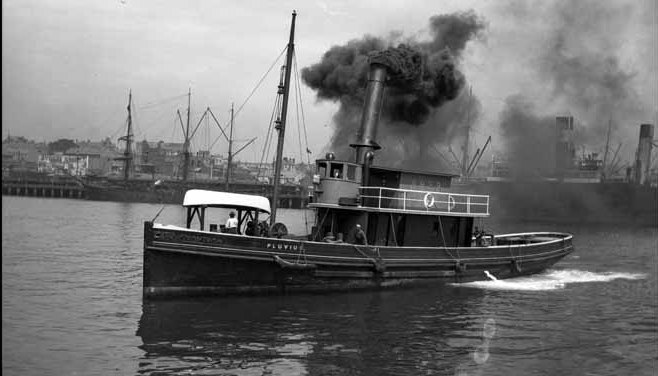 CHAIN-GANGS of convicts were taken to Goat Island from the hulk Phoenix in 1833 to transform the place into a powder magazine depot. They were accommodated in three wooden huts surrounded by a stockade. By 1838, the sweating convicts had completed the magazine structures, and were then put to building a barracks for the harbour water police. This they completed by 1839.
CHAIN-GANGS of convicts were taken to Goat Island from the hulk Phoenix in 1833 to transform the place into a powder magazine depot. They were accommodated in three wooden huts surrounded by a stockade. By 1838, the sweating convicts had completed the magazine structures, and were then put to building a barracks for the harbour water police. This they completed by 1839.
The Pluvius ANMM image
Sandstone for the buildings was quarried on the island. At the time, Goat Island's quarries were considered to be the best in the colony, and many Government buildings subsequently built in and around Sydney in the early days were constructed from the island stone.
The 100ft long, six-feet thick walled, arched-roofed magazine, and another sturdy building nearby are used now by the Maritime Services for departmental shipwright work. Workmen travel over daily from the mainland. The old magazine is used now as a storeroom, and the other building as offices for the department's shipwright depot. Both buildings are as good as ever they were, as are the old water police buildings and a residence which was originally the home of the military commander of the island. The old police barracks are used now to house single members of the water fire brigade. The actual police station building is occupied as a residence by Mr. and Mrs. Fleck.
I’d love to live in the Fleck's house. It has undergone certain interior alterations, of course, but the solid old walls, with their arched doorways, and the general architecture of the place carry an atmosphere of old time tranquillity. Even though it was once a police station!
For the first 40 years of colonisation, Goat Island, originally called "Milmil" by the blacks, was left in its natural state, undisturbed. Then, Governor Bourke, in 1833, took up the strings where his predecessors had left off on the idea of making use of the island for military purposes, and its history commenced. You can still see, bayonet-inscribed on the thick walls of an antiquated sandstone sentry-box on the western side of the island, the initials and crude attempts at carving of garrison troops-men of the Royal Irish Regiment and other Imperial soldiers stationed there in the mid-eighties. The island ceased to have any, military significance in 1868, when it became merely a storing place for minor explosives and ammunition. In 1900 its administration was transferred to the harbour authorities. In the early part of this century it was the location of residence for the Harbourmaster.
It became the headquarters for the port fire brigade in 1901, when the equipment consisted of only one fire float, the Pluvius.
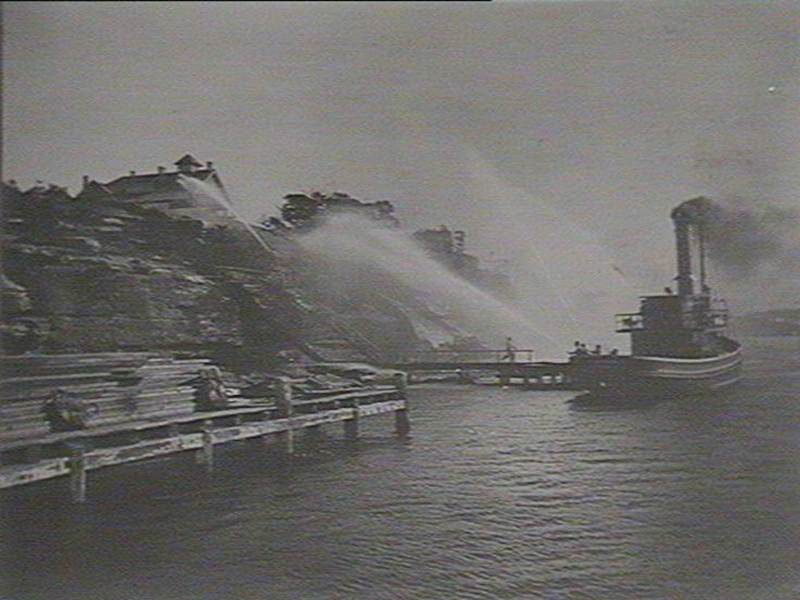
The Pluvius, 1903
The Pluvius, still the most powerful water fire-fighting unit in the southern hemisphere, is now number one float in a fleet of five, which includes the emergency and control vessel, the Endeavour. The complete control of the brigade is done by radio telephone, with which all vessels are equipped. The control station is at Goat Island. Each float is capable of pumping 2,500 gallons of water a minute through eight lines. They are equipped also with fire-monitors-the fire-fighter's machine-gun-which will throw a high-velocity jet of water a distance of 130 feet. If I had known all this 30 years ago, I think I would have joined the Sydney Harbour Fire Brigade ...just for the joy of living on Goat Island. Fire-Fighters are Goat Islanders, By FRANK SNOW. (1946, October 26). The Sydney Morning Herald (NSW : 1842 - 1954), p. 6. Retrieved from http://nla.gov.au/nla.news-article18000297
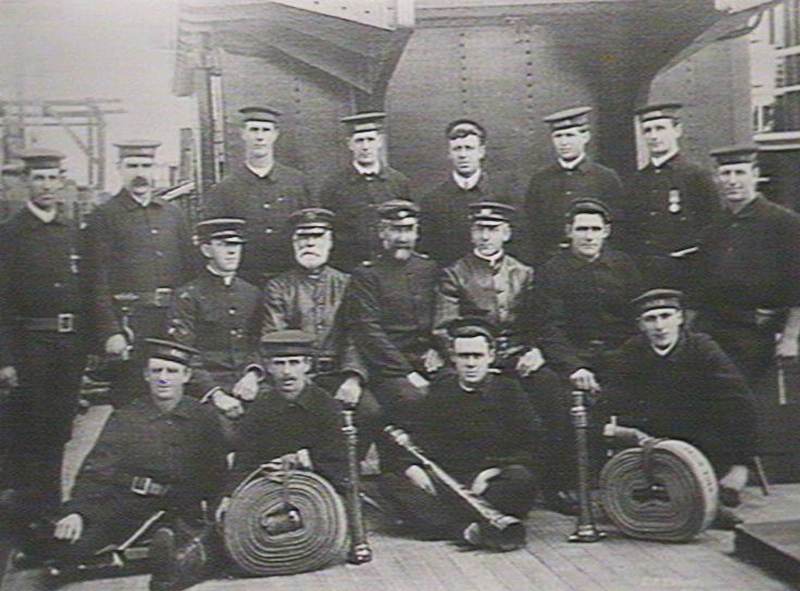
Sydney Harbour Trust Fire Brigade, Sept 1913. Image No.: d1_48357, courtesy State Library of NSW.
The earliest official recorded fire fighting unit for the Northern Beaches originated at Manly as early as 1868. Other sources state the Manly Volunteer [Fire Fighting] Company was formed in June 1877 and occupied premises in Market Square. The Company was registered with the Metropolitan Fire Board in 1886 as Station No.24.
The volunteers owned the premises from which the brigade operated in 1895. A new station in Sydney Road opened 25 February 1898. By 1903 Manly had partially-paid staff (1). First permanent staff were appointed in 1912. A new station on the corner of Sydney Road and Thornton Street opened 17 August 1921 (2).
During this first period of on water or beside water fires vessels attached to the Maritime Board and Harbour Authority Trust attended fires. Those frequently sent were pilot tugs. William Douglas Bear (Superintendent Metropolitan Fire Brigade from 1884 to 1898), who had to attend fires on and around the numerous warehouses now on Sydney Harbour, pointed out that something else was needed;
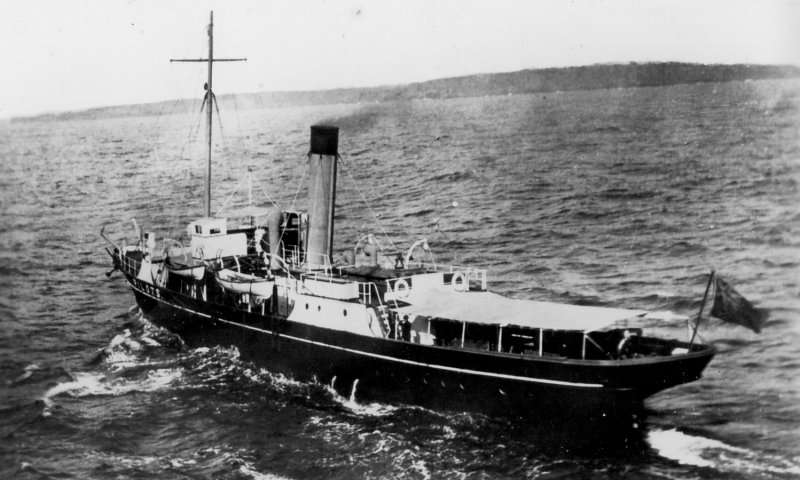 STATEMENT BY SUPERINTENDENT BEAR.
STATEMENT BY SUPERINTENDENT BEAR.
" As soon as we received the call," remarked Mr. Bear to a Herald reporter yesterday, " and had let Nos. 1, 2, and 3 stations know, we turned out with an engine and salvage van. We galloped along towards Balmain but as soon as we got on the other side of the Pyrmont Bridge we found out that the fire was in Johnstone's Bay, and, although it was a long way from Balmain, we thought it was over at the wharfs there. The next move was made towards the Sugar Company's wharf. When we got there I saw the watchman, and I told him to send a message to the Captain Cook. It seemed to me then that the three ships were getting alight. At last we got a boat, and succeeded in getting a couple of men on board. After I had been on board I thought that the best way to set to work was to tackle it from the shore, and we run off a thousand feet of hose with some small boats that were lent us. We soon had the hose at work but we first extinguished the fire on the Emu. Then we sent ashore for some hose and a branch from our steamer to work the tugboat Reliance, because she had no nozzle, and we had to put on our own hose. When we got the fire well in hand the Captain Cook came up. As soon as the Emu was finished with we were enabled to concentrate our strength on the Victorian. It appeared to me that the fire broke out in the saloon of the Victorian and worked its way forward and aft. Well, I suppose that from the time we started up to half-past 7, it took us that long to put the fires out. What we were afraid of was the steamers passing over our hose across the harbour. Two or three did pass over, and they took no notice of our signs to them. If they had picked up our hose we would have been in a nice predicament. I was waiting for the Captain Cook to come up when we first got there, and I did so as long as possible ; but if she had been there in the first instance we would not have run the hose from the shore. We tried ourselves, when we first got on board, before I gave tho order to slack the chain, to get the other two vessels away from the Victorian, because she was so much alight on the star-board side that there was then imminent danger of setting the others alight. Indeed, the fire had gone right through her portholes into the cabins of the Emu.
On Superintendent Bear being asked if it was true that the Harbour is outside the metropolitan district, Mr Bear replied,
" It is quite true that Port Jackson is not included in the Metropolitan area specified by the Fire Brigades Act of 1884. Strictly speaking we have no right to attend a fire there, and in this very instance I have disobeyed the instructions of my board, which wore that I was to have the money down before I attempted to put out any fire there. I am busily engaged us you see in explaining why I disobeyed that instruction yesterday morning. I have no jurisdiction in the harbour. I could not stop the steamers this morning from crossing my lines of hose, and had one of the screws caught hold of one of the lines it would have ruined it, besides endangering the lives of some of the firemen attending the hose. Again, if one of the vessels on fire this morning by some chance had broken away I bad not the appliances to deal effectively with it.
You are referring to a float ?
The time has come most certainly when a powerful floating fire-engine should be attached to the brigade. In fact, when the fire station at Circular Quay was built it was with the intention of manning a float from it. Now that the new wharfs are being constructed it would be a very opportune time to arrange the position of the float. It should be always under steam. This could be done by having two boilers, in one of which the steam could be up, and a fire laid in the other which would be connected with a beater, so that in ease of fire it could lit and steam got up in a very short 'time. The float would be available for use along the wharfs as well as out in the harbour. In fact there are many parts of the harbour which it is impossible to reach at the present moment with fire appliances of any kind at hand. A float would be able to reach these places. If a vessel were to take fire in any of them, we as a brigade would be perfectly helpless. I consider that a float attached to the Northern Fire Station would not cost more than £1000 per year for maintenance. This is the second largest harbour in the. world, and it is rather strange that we are without proper fire-extinguishing appliances. Through the port not being included in the Act of 1881 there are no funds available for the purchase of a float. I think it would be only a fair thing for the Government to find the money, and the underwriters and the shipping firms to allow a certain amount yearly to the Fire Brigade Board. The float would not only be useful for putting out fires, but it would be valuable to the underwriters for pumping out vessels at anytime.
Do you mean that our shipping is unprotected from fire ?
Yes, that is practically the position. I look upon the Captain Cook as a very good boat for the purpose for which it was intended, but the men on board are untrained in firemanship. That fact discounts the value of the boat considerably for fire-extinguishing purposes. Again, the Captain Cook is not only stationed too far down the harbour, but she may be out to sea altogether at the time of a fire. If one of our mail boats or one of the large ocean-going steamers was alight down the bay, and the Captain Cook out of the harbour, there is nothing to cope with such afire. STATEMENT BY SUPERINTENDENT BEAR. (1895, August 23).The Sydney Morning Herald (NSW : 1842 - 1954), p. 5. Retrieved from http://nla.gov.au/nla.news-article14007915
The Captain Cook W.D. Bear refers to here is the second pilot vessel of this name on Sydney Harbour, Captain Cook II. This vessel had none of the sepcialised water pumps needed for fighting fires and was frequently called to attend emergencies up and down the coast. She was stationed at Watson's Bay. The second of three Captain Cooks to serve as pilot vessels, she weighed 396 gross register tons and 172 net. She was built by Morts Dock & Engineering Co. of Balmain, Sydney, Australia,in 1893 and had a length of 155.8 feet, a width of 25.2 feet, and a depth of 13 feet, had 1 deck, and 3 cylinder engines which could attain 85hp. Registered in the port of Sydney, she belonged to the N.S.W. Government as part of its Maritime Services Board.
The Metropolitan Fire Brigade's call for fire floats did result in improvements being made to the newly commissioned Pluvius:
THE FIRE PROTECTION OF SYDNEY HARBOUR.
THE Sydney Harbour Trust is evidently fully alive to the necessity of effectually protecting the shipping and waterside warehouses and other premises adjacent' to Sydney harbour. Messrs. Merryweather and Sons, London, have just supplied to the order of the trust, one of their new, powerful compound steam pumping engines, capable of delivering 2000 gallons of water per minute. This has been bought through the firm's agents in Sydney, Messrs. Gibson, Hattie, and Co., and has been fixed on a first-class tug boat, the whole forming a powerful steam fire float. The pumps will enable a solid 2 ½ in. stream to be thrown or as many as twelve smaller jets simultaneously. THE FIRE PROTECTION OF SYDNEY, HARBOUR. (1903, May 12). Morning Bulletin (Rockhampton, Qld. : 1878 - 1954), p. 4. Retrieved from http://nla.gov.au/nla.news-article52990507
Mr Bear's duties were taken over by Alfred Webb, (Supt. Metropolitan Fire Brigade 1898 to 1910). He too had to attend fires in warehouses and on the cargo vessels loading from them. He too wanted and needed a fire-boat or fire-float;
"Oh, yes; two-thirds of what we used was salt water. We had the Pluvius, the Harbour Trust boat, going up till 6 o'clock."
"What would have been the result, then, had you had to depend upon the main?"
"If we had not had the salt water tho fire would have got ahead of us. … We might have done better-I don't say we could, but we might-if we had a powerful fire-float attached to our plant such as has been advocated for some years. Round Port Jackson we have 700 miles of waterfrontage so that there is a tremendous lot of property to guard, besides which the saving in consumption of fresh water would be tremendous." WHAT SUPERINTENDENT WEBB SAYS. (1906, February 24).The Sydney Morning Herald (NSW : 1842 - 1954), p. 11. Retrieved April 26, 2013, from http://nla.gov.au/nla.news-article14754954
FIRE ON A STEAMER. COPRA CARGO CAUGHT. VESSEL FLOODED. A fire occurred at Woolloomooloo Bay on Saturday morning, when part of the cargo of the steamer Varzin was burnt, and the hold had to be flooded to save the balance. What threatened to be a serious fire was only kept in limits, and ultimately subdued, by the combined and energetic efforts of the Metropolitan Fire Brigade, the Harbour Trust firemen, detachments of blue jackets from Garden Island, and the crew of the steamer. The outbreak is supposed to have resulted from spontaneous combustion in a shipment of copra.
The firemen were speedily reinforced by the Harbour Trust Brigade, under Captain Pritchard, and a detachment of blue jackets from Garden Island, under Lieutenant Jefferson. The Harbour Trust men came on the scene in the fire-float Powerful, and in a few minutes four lines of hose from the steamer's strong pumps were added to the battery pouring water into the hatchway. The navy also contributed their quota. The handymen brought with them their Merryweatherland engine from Garden Island. They had it lashed on to a water tender, which was moored alongside the Varzin. Two lines of hose were worked by the blue Jackets, who also assisted the firemen on the ship by directing the branches down the hold, a very disagreeable job, on account of the pungent smoke which issued in dense masses from the burning copra.
When all the engines and other appliances were working there were 20 streams of water being poured into the vessel. This represented about 4000 gallons a minute, and as there was a large quantity of cargo in the hold, it was not long before the water made its presence felt. ... It is not possible to estimate the damage done. The agents received permission from the underwriters to discharge the cargo, which will be done at once. The actual damage will then be arrived at. The cargo affected comprised 3500 bags of, copra, 250 bales of wool, and a quantity of sundries.A large crowd of interested spectators gathered on the wharfs, despite the heavy rain which fell, and only dispersed when the engines returned to the stations. The firemen were assisted by a strong body of police, under Inspector M'Vano and Sub-Inspector Spence, who kept the crowd from trespassing too near the scene of operations. FIRE ON A STEAMER. (1907, June 17). The Sydney Morning Herald (NSW : 1842 - 1954), p. 8. Retrieved April 26, 2013, from http://nla.gov.au/nla.news-article14851051
Fire-floats were in essence floating fire engines and would often have to be towed to where they were required before engines were installed on them. The need to fight fires on the harbour, which even today runs at an average of 200 per year, required the expansion of this fleet;
The Chief Secretary states that it is estimated that a suitable fire float for Sydney Harbor would cost £20,000. The question is engaging attention in connection with the draft fire Brigades Bill. NEWS OF THE WEEK. (1907, November 27). Australian Town and Country Journal (NSW : 1870 - 1907), p. 14. Retrieved from http://nla.gov.au/nla.news-article71599139
PICTURE: FIRE-FIGHTING FLOATS PUT THROUGH THEIR PACES. Used to 'fight waterside fires, the fire-floats Pluvius and Hydra are among the best equipped in the world. The floats are shown in action during one of the several trials they have each year. FIRE-FIGHTING FLOATS PUT THROUGH THEIR PACES. (1937, September 24). The Sydney Morning Herald (NSW : 1842 - 1954), p. 12. Retrieved from http://nla.gov.au/nla.news-article17400749
New Fire Float On The Harbour A new fire float has just been handed over to the Maritime Services Board's fire brigade. It is the brigade's first new float for almost 40 years. The float, named the Boray, is 100 feet long and is fitted with modern British pumps capable of throwing jets of foam 150 feet. New Fire Float On The Harbour. (1950, May 17). The Sydney Morning Herald (NSW : 1842 - 1954), p. 6. Retrieved from http://nla.gov.au/nla.news-article18163089
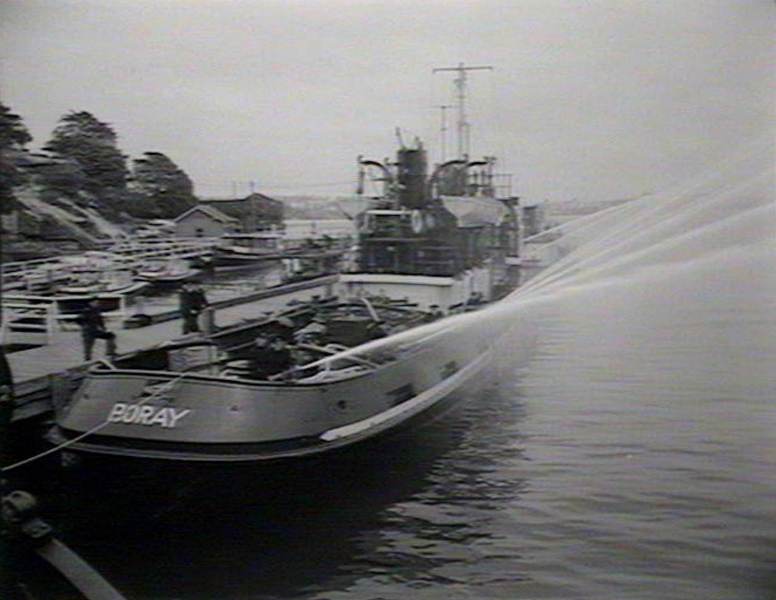
The Boray, 1951. Image No.: 10057h, courtesy State Library of NSW.
RADIO FOR SMALL SHIPS. Sydney. – Amalgamated Wireless has been commissioned to supply and install a frequency modulation radio network for the Maritime Services Board. The system will comprise a central station' housed' in the board's head office building, which is to be occupied next month, and twelve mobile stations. The network will provide a two-ways radio telephone service between the board's offices and its. vessels engaged on harbour duties. The twelve vessels carrying the radio ' telephones will include the fire floats Burrawarec and Boray, which replace the Hydra and the Pluvius, and the new fire float Bennelong. RADIO FOR SMALL SHIPS. (1952, December 3). Barrier Miner(Broken Hill, NSW : 1888 - 1954), p. 5. Retrieved April 26, 2013, from http://nla.gov.au/nla.news-article61226773

Launching of the Bennelong: Goat Island, 26.11.51, Government Printing Office 1 - 10055, courtesy State Library of NSW.
The first verifiable record of whom attended fires on vessels in Pittwater, apart from those closest to hand, stems from a 1947 report:
WOMAN RESCUED FROM FIRE ON TRAWLER MOORED NEAR PITTWATER
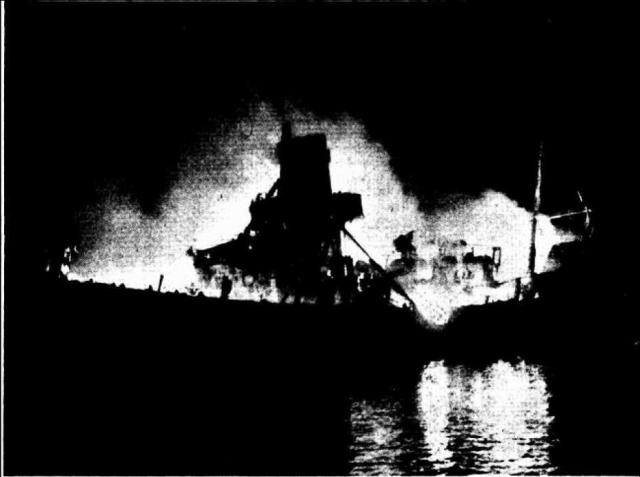 The 75-ton trawler Trusan burning fiercely at its moorings near Pittwater last night. The only person aboard, Mrs. Alice Stevenson, was rescued by dinghy. Firemen stood helpless as the ship burnt out.
The 75-ton trawler Trusan burning fiercely at its moorings near Pittwater last night. The only person aboard, Mrs. Alice Stevenson, was rescued by dinghy. Firemen stood helpless as the ship burnt out.
A woman stood on some timber floating beside a burning trawler in Saltpan Bay, near Pittwater, last night and screamed for help until she was rescued. Her husband said she was expecting a baby in two months. The trawler Trusan, of 75 tons and valued by its owner at £25,000, was burnt out at its moorings. FELL WITH LAMP
"I rushed down to the water's edge and found that my wife had been rescued. My wife escaped the blaze by clambering over the side on to a makeshift raft. She remained there screaming for help until a man on shore saw her. He took a dinghy out and brought her to safety. My wife told me that she was carrying a lighted oil lamp down the aft companionway to the crew's quarters when she tripped and fell. The lantern smashed against the deck, which had been newly painted. Before my wife could do anything the paint caught alight and the fire became out of control."
Between 800 and 1,000 gallons of diesel oil was in the trawler. Firemen stood helpless on the shore while the ship blazed from stem to stern. Mr. Stevenson tried to save the trawler by sinking her. With two other men he went out in a dinghy to cut a hole in the side of the trawler, with an axe. The heat was too in- tense, and they could get no nearer than about 30 feet. Mr. Stevenson was almost in tears as he watched the vessel burn. Fire brigades from Crow's Nest, Avalon and Narrabeen could do nothing to save it. District Officer F. Russo, who was in charge, said it was impossible to fight the fire. The trawler was anchored about 250 yards from the shore. The firemen could not get near enough to stem the blaze. A fire brigade launch manned by volunteer reserve fire men circled the trawler at about 9 p.m., but she was then very low in the water and blazing fiercely. There was a great danger of many of the drums of oil on board exploding.At midnight the flames were beginning to die down. The trawler had settled very low in the water. Mr. Stevenson said he had had the trawler for about 18 months. He bought her in Western Australia for £25,000. He and his wife and a crew of eight had been pearling near Thursday Island until a month ago. He said he was not sure whether he would be paid insurance money, because the trawler had been insured in Western Australia. Illustrated. WOMAN RESCUED FROM FIRE ON TRAWLER MOORED NEAR PITTWATER. (1949, May 20). The Sydney Morning Herald (NSW : 1842 - 1954), p. 1. Retrieved from http://nla.gov.au/nla.news-article18115647
The need for on hand organised people in the event of life threatening fires, especially in a place where so much water access is required, came from the people in Pittwater;
Pittwater Fire Boats
By Ian White, Captain of Scotland Island Rural Fire Brigade
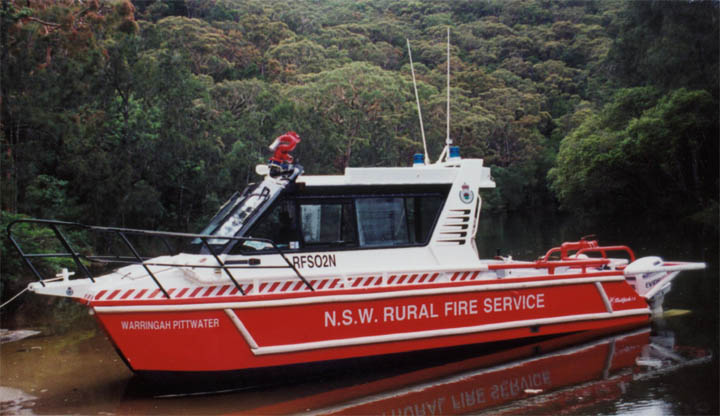 Scotland Island Rural Fire Brigade was formed in the Easter holidays of 1955 when a small number of residents met at ‘Bangalla’ and formed a progress association. Their first priority was to establish the Scotland Island Volunteer Bush Fire Brigade to organise the individual efforts of the Island and the Western Foreshores.
Scotland Island Rural Fire Brigade was formed in the Easter holidays of 1955 when a small number of residents met at ‘Bangalla’ and formed a progress association. Their first priority was to establish the Scotland Island Volunteer Bush Fire Brigade to organise the individual efforts of the Island and the Western Foreshores.
A shed was constructed by the residents near Tennis Wharf and the first fire vehicle, a jeep with a 44 gallon drum on it, was donated. Over the years, the equipment of the Brigade has improved and a new Fire Station was constructed in 1991 on the current site above Catherine Park. Since 1955, the Brigade has attended numerous house fires on the Island and several small wildfires.
The first Scotland Island Fire boat dates back to the early 1970s. This was an old donated tinny with an old 15hp engine and a portable fire pump bolted to the floor. I don't believe that this fire boat was ever called out to a fire. Corrosion made this design quite impractical.
In the late 1990s two fire boats were ordered for the Scotland Island and West Pittwater Rural Fire Brigades. These were both 6 metre flat bottomed barges with 30hp motors and marinised fire pumps. These boats were fitted with proper fire fighting equipment and radios. However, their limitations with dealing with boat fires and not being suitable for work outside Pittwater led to the Rural Fire Service commissioning two purpose built Rural Fire Boats in 2000.
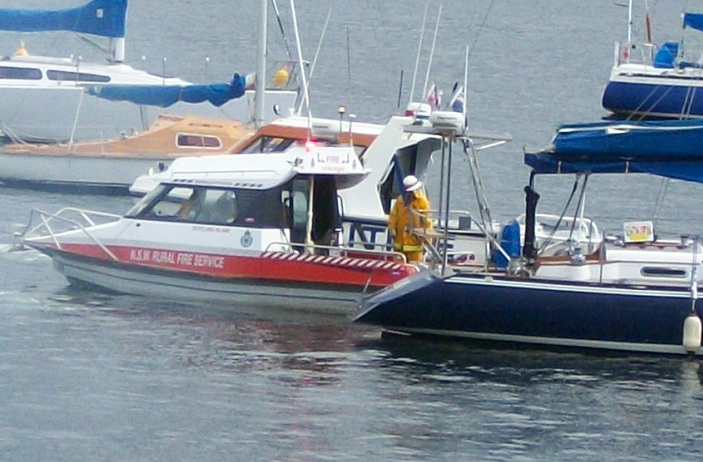
The new fire boats were 7 metre catamarans with twin 170hp Johnson outboards and large marinised diesel firefighting pumps. One of these boats was allocated to Scotland Island Brigade and the other was allocated to the Headquarters Brigade in Terrey Hills (on a trailer). The size and speed of these new boats meant that they could carry much more equipment and could be used for boat fires. The large pumps made them very useful for fires in Broken Bay and up the Hawkesbury. After 10 years of service the last cat was retired. The design has proved to be a big improvement but the running costs, limited range and poor reliability had proved problematic.
A new 7.8 metre stabicraft with a single 200hp outboard and a smaller lighter pump was built for the Scotland Island Rural Fire Brigade in 2006 This appliance is designed as a quick response boat. It is intended to get to boat, marina, water access bush and structure fires quickly. In 2011 an new purpose built fire barge was built for the West Pittwater Brigade. This barge is more than 8 meters long and is designed to transport crews and equipment and also to be a shallow draft high volume pumping platform.
Today the two Pittwater Fire boats one located on Scotland Island and the other in Elvina Bay are manned by volunteers. These boats are jointly called out for boat fires, marina fires, waterfront access bush and structure fires in Pittwater and Broken Bay.
Over the last 20 years Rural Fire Service volunteers have attended many boat fires and have Saved and protected hundreds of thousands of dollars with of property.
Top Photo: The old fire boat which was used by the Warringah Pittwater Rural Fire Service.It was a catamaran hulled boat with 2x225hp counter rotating outboard motors. There is a pump on the back work area, stainless steel to reduce corrosion from pumping salt water, the same design and water output as the RFS fire engines. The red thing on the roof is a monitor. Plumbing can be seen running the length of the boat on this side along the gunwhale. Surveyed to carry a crew of 6. Photo courtesy of Martyn Schafer. Above Photo: NSW Rural Fire service boat at the Royal Motor Yacht Club - Broken Bay's Multi-agency Emergency Training Drill of March, 2012. Photo by A J Guesdon.
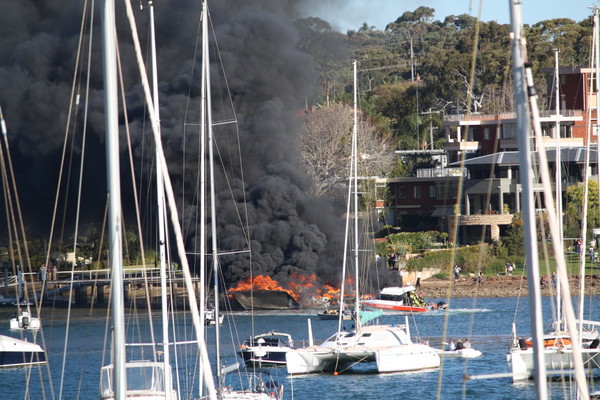 The incidents of on board fires and bushfires in Pittwater ranges from before records were made and accounts of these events fill papers since. One of the most recent and memorable of these is the July 22nd 2009 blaze at Newport Anchorage Marina. Photo to right by Damian Devine.
The incidents of on board fires and bushfires in Pittwater ranges from before records were made and accounts of these events fill papers since. One of the most recent and memorable of these is the July 22nd 2009 blaze at Newport Anchorage Marina. Photo to right by Damian Devine.
Although vessels were lost and new ways to deal with such blazes on water have become part of finessing training exercises for local brigades since, what is recalled most by witnesses is that we don't stand by and look on;
What I remember of the 2009 event was the sheer volume of thick, black, dense smoke – it was incredible and the noise it made, it was scary. I thought, at the time, it must have be catastrophic to people and property. The actions of everybody to get in and support the emergency services was amazing and symbolised the Aussie spirit.
Damian Devine
The latest most recall is those of earlier this year;
Towlers Bay Fire (Pittwater LGA) 18/01/13 20:49 Posted: A fire is burning in the Ku-ring-gai National Park in the Pittwater area. Current Information Firefighters are working to contain the fire which is burning on West Head within the Ku-ring-gai National Park. Remote properties, accessible only by water, in areas including Lovett, Morning and Elvina Bays may experience smoke and embers. Crews are in place to protect properties in these areas. Full marks to those men and women volunteers fighting fires in this heat.
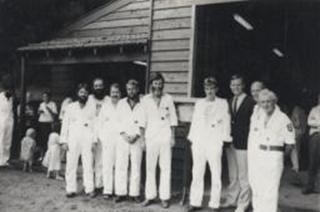 We spoke to Captain Kylie Stackhouse of the West Pittwater Rural Fire Brigade who recalled the fire-boat was used to fight this blaze; 'How much water have you got?' came the call from the top of the hill; Kylie, pump into the salt waters, said back 'How much do you want?' proving that accessing all that salt water to fight fires, over a hundred years on, is still an obvious asset.
We spoke to Captain Kylie Stackhouse of the West Pittwater Rural Fire Brigade who recalled the fire-boat was used to fight this blaze; 'How much water have you got?' came the call from the top of the hill; Kylie, pump into the salt waters, said back 'How much do you want?' proving that accessing all that salt water to fight fires, over a hundred years on, is still an obvious asset.
Left: Elvina, the early days, courtesy West Pittwater Rural Fire Service website.
The West Pittwater Rural Fire Service, servicing the southern Western Forsehores of Pittwater, including the offshore communities of McCarrs Creek, Elvina Bay, Lovett Bay and Morning (Towlers) Bay has Stations in Elvina (South) and Lovett (North). They have two Category 7 tankers; Elvina 7 and Lovett 7, one Personnel Carrier Elvina PC and the South Pittwater, second response fireboat, West Pittwater 15. The unofficial name of this vessel is 'the Bob Anderson' after a former Captain aof this brigade and long term resident. Officially she is The Elvina Boat.
Our Rural Fire Brigades, staffed by volunteers, are part of the largest volunteer fire fighting brigade worldwide, with over 70 000 members. They are the difference between life and death for many in Australia and have their counterparts, under other names, in every state of Australia. Here in Pittwater they are always those folk who get on quietly with the job required as well as their day jobs. Their attitude is 'look at this!' referring to the devastation wrought by fires and people unprepared for them rather then a 'look at me' attitude.
More hands are always needed for such work in a wide range of roles. Details on the NSW Rural Fire Service website HERE.
References:
(1) Annual Report 1903 p.12
(2) Colin Adrian, Fighting Fire A Century of Service 1884-1984, p.253
Scotland Island Rural Fire Brigade: http://www.sirfb.org.au/
West Pittwater Rural Fire Brigade: http://www.westpittwater.rfsa.org.au/index.htm
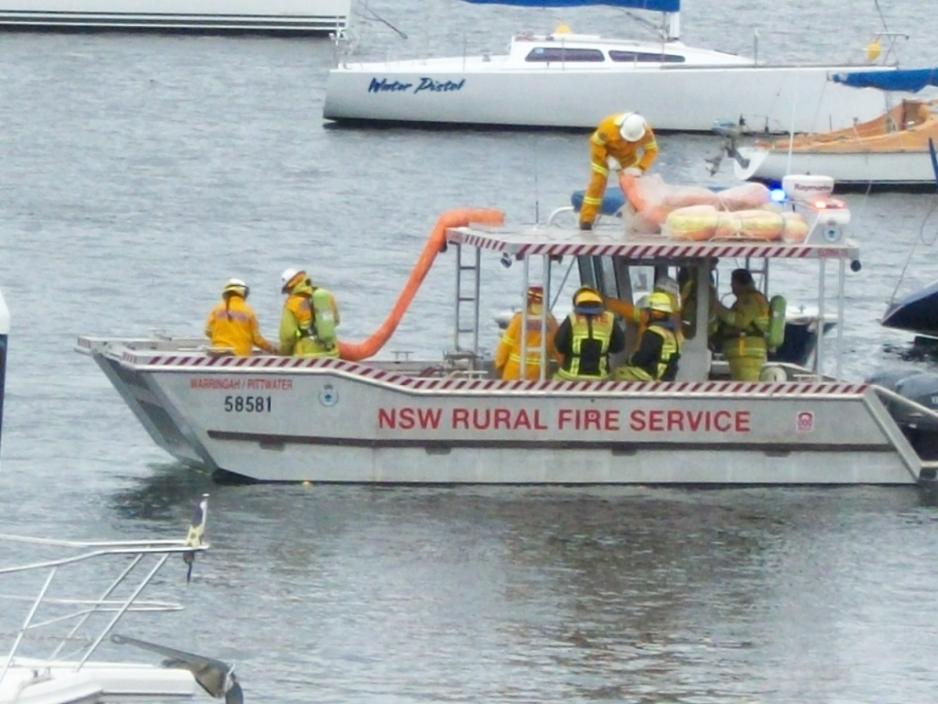
SIRFB History by Ian White. Extra threads collected by A J Guesdon, 2013.